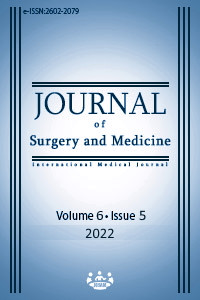Clinical significance of pathologically detected lesions in reduction mammoplasty
Keywords:
Mammoplasty, Atypical hyperplasia, DCIS, Breast carcinomaAbstract
Background/Aim: Breast reduction surgery is performed for various reasons, especially macromastia. Although the mammoplasty material obtained after surgery is generally accepted as normal breast tissue, incidental breast cancer or precursor lesions of breast cancer are also observed in these materials. Detection of these lesions will provide important information both for the risk developing breast cancer in the normal population and for the early treatment of these lesions. Our study aimed to investigate the rate of occurrence of high-risk lesions, such as atypical ductal hyperplasia (ADH), atypical lobular hyperplasia (ALH), and carcinoma in situ (DCIS, LCIS) and the relationship of these lesions with patient age and weight of the resected material. Methods: This study was a retrospective cohort study examining incidentally detected pathological lesions after examining reduction mammoplasty materials after breast reduction in our pathology department between 2011 and 2021. None of the cases had been previously diagnosed with breast cancer. The cases were pathologically classified as benign lesions, high-risk lesions with atypia, and in situ carcinoma. The association of atypical high-risk lesions with age (> 40 and ≤ 40 years) and resection weight was evaluated. Results: The surgical materials of 288 breasts were evaluated in a total of 144 women. The mean age of the patients was 38.9 years. Atypical high-risk lesions, such as ADH, ALH, and DCIS were detected in seven patients (4.8%). İnvasive cancer was not observed. The mean age of the patients with risky lesions was 45.98 years, and the mean weight of these lesions was 2,045 grams. Cases with high-risk lesions were older (P = 0.041) and had a higher resection weight (P = 0.003). Conclusion: The findings in our study reveal the necessity for mandatory histopathological examination of reduction mammoplasty materials. This examination is even more important in terms of high-risk lesion detection, especially in patients over 40 years and those with a high resection weight. In these cases, taking more tissue samples than used for the other situation for examination is recommended.
Downloads
References
Ishag MT, Bashinsky DY, Beliaeva IV, Niemann TH, Marsh WL Jr. Pathologic findings in reduction mammaplasty specimens. Am J Clin Pathol. 2003 Sep;120(3):377-80.
Tozbikian G, Brogi E, Vallejo CE, Giri D, Murray M, Catalano J et al. Atypical Ductal Hyperplasia Bordering on Ductal Carcinoma In Situ. Int J Surg Pathol. 2017 Apr;25(2):100-7. doi: 10.1177/1066896916662154.
Nielsen M, Thomsen JL, Primdahl S, Dyreborg U, Andersen JA. Breast cancer and atypia among young and middle-aged women: a study of 110 medicolegal autopsies. Br J Cancer. 1987 Dec;56(6):814-9. doi: 10.1038/bjc.1987.296.
Thomas ET, Del Mar C, Glasziou P, Wright G, Barratt A, Bell KJL. Prevalence of incidental breast cancer and precursor lesions in autopsy studies: a systematic review and meta-analysis. BMC Cancer. 2017 Dec 2;17(1):808. doi: 10.1186/s12885-017-3808-1.
Dotto J, Kluk M, Geramizadeh B, Tavassoli FA. Frequency of clinically occult intraepithelial and invasive neoplasia in reduction mammoplasty specimens: a study of 516 cases. Int J Surg Pathol. 2008 Jan;16(1):25-30. doi: 10.1177/1066896907307176
Usón Junior PLS, Callegaro Filho D, Bugano DDG, Geyer FC, de Nigro Corpa MV, Gonçalves PDS, et al. Incidental Findings in Reduction Mammoplasty Specimens in Patients with No Prior History of Breast Cancer. An Analysis of 783 Specimens. Pathol Oncol Res. 2018 Jan;24(1):95-9. doi: 10.1007/s12253-017-0230-6.
Pitanguy I, Torres E, Salgado F, Pires Viana GA. Breast pathology and reduction mammaplasty. Plast Reconstr Surg. 2005 Mar;115(3):729-34; discussion 735. doi: 10.1097/01.prs.0000152683.62899.50.
Desouki MM, Li Z, Hameed O, Fadare O, Zhao C. Incidental atypical proliferative lesions in reduction mammoplasty specimens: analysis of 2498 cases from 2 tertiary women's health centers. Hum Pathol. 2013 Sep;44(9):1877-81. doi: 10.1016/j.humpath.2013.02.015.
Mastroianni M, Lin A, Hughes K, Colwell AS. Proliferative Lesions Found at Reduction Mammaplasty: Incidence and Implications in 995 Breast Reductions. Plast Reconstr Surg. 2019 Feb;143(2):271e-275e.
Siegel RL, Miller KD, Goding Sauer A, Fedewa SA, Butterly LF, Anderson JC, et al. Colorectal cancer statistics, 2020. CA Cancer J Clin. 2020 May;70(3):145-64. doi: 10.3322/caac.21601.
Hartmann LC, Sellers TA, Frost MH, Lingle WL, Degnim AC, Ghosh K, et al. Benign breast disease and the risk of breast cancer. N Engl J Med. 2005 Jul 21;353(3):229-37. doi: 10.1056/NEJMoa044383.
Wang J, Costantino JP, Tan-Chiu E, Wickerham DL, Paik S, Wolmark N. Lower-category benign breast disease and the risk of invasive breast cancer. J Natl Cancer Inst. 2004 Apr 21;96(8):616-20. doi: 10.1093/jnci/djhs105.
Cook IS, Fuller CE. Does histopathological examination of breast reduction specimens affect patient management and clinical follow up? J Clin Pathol. 2004 Mar;57(3):286-9. doi: 10.1136/jcp.2003.012427.
Ambaye AB, MacLennan SE, Goodwin AJ, Suppan T, Naud S, Weaver DL. Carcinoma and atypical hyperplasia in reduction mammaplasty: increased sampling leads to increased detection. A prospective study. Plast Reconstr Surg. 2009 Nov;124(5):1386-92.
Acevedo F, Armengol VD, Deng Z, Tang R, Coopey SB, Braun D, et al. Pathologic findings in reduction mammoplasty specimens: a surrogate for the population prevalence of breast cancer and high-risk lesions. Breast Cancer Res Treat. 2019 Jan;173(1):201-7.
Ambaye AB, Goodwin AJ, MacLennan SE, Naud S, Weaver DL. Recommendations for Pathologic Evaluation of Reduction Mammoplasty Specimens: A Prospective Study With Systematic Tissue Sampling. Arch Pathol Lab Med. 2017 Nov;141(11):1523-8.
Fisher M, Burshtein AL, Burshtein JG, Manolas P, Glasberg SB. Pathology Examination of Breast Reduction Specimens: Dispelling the Myth. Plast Reconstr Surg Glob Open. 2020 Nov 24;8(11):e3256.
Wisse A, Tryggvadottir H, Simonsson M, Isaksson K, Rose C, Ingvar C, et al. Increasing preoperative body size in breast cancer patients between 2002 and 2016: implications for prognosis. Cancer Causes Control. 2018 Jul;29(7):643-56. doi: 10.1007/s10552-018-1042-z.
Tadler M, Vlastos G, Pelte MF, Tille JC, Bouchardy C, Usel M, et al. Breast lesions in reduction mammaplasty specimens: a histopathological pattern in 534 patients. Br J Cancer. 2014 Feb 4;110(3):788-91. doi: 10.1038/bjc.2013.708.
Downloads
- 585 471
Published
Issue
Section
How to Cite
License
Copyright (c) 2022 Remzi Arslan
This work is licensed under a Creative Commons Attribution-NonCommercial-NoDerivatives 4.0 International License.
















